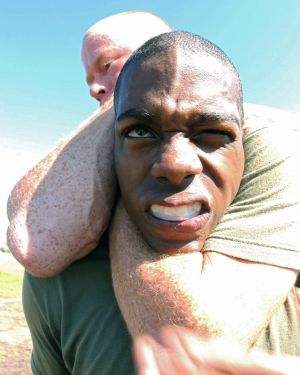Strangulation: Difference between revisions
ClaireLewis (talk | contribs) No edit summary |
|||
| (7 intermediate revisions by 2 users not shown) | |||
| Line 1: | Line 1: | ||
==Background== | ==Background== | ||
[[File:MCMAP Rear choke - Defense Visual Information Center 2006.jpg|thumb|An example of strangulation ("blood choke") from a rear naked choke.]] | |||
[[File:Gray513.png|thumb|Anatomy of neck arteries.]] | |||
[[File:Human anatomy, including structure and development and practical considerations (1911) (14594049867).jpg|thumb|Midline neck anatomy on lateral view.]] | |||
*Strangulation | *Strangulation | ||
**Hanging, ligature, manual or postural strangulation | **Hanging, ligature, manual or postural strangulation | ||
| Line 22: | Line 25: | ||
==Clinical Features== | ==Clinical Features== | ||
[[File:PMC5392724 gr1.png|thumb|Strangulation marks sustained after scarf-related strangulation injury.]] | |||
*Facial [[petechiae]] | *Facial [[petechiae]] | ||
*Ecchymoses | *Ecchymoses | ||
| Line 55: | Line 59: | ||
*[[CT brain]] | *[[CT brain]] | ||
*CT cervical spine | *CT cervical spine | ||
*CTA neck | *CTA neck criteria from Taming of the Sru Grand Rounds <ref>[http://www.tamingthesru.com/blog/grand-rounds/recap-110619 Taming of the Sru Grand Rounds Recap 11.6.19 accessed 11/25/2019. Copy permission given by CC BY-NC-SA 4.0 license Taming of the Sru Website]</ref>directly quoted below: | ||
**''Guidelines for imaging: GCS<8, audible neck bruit, expanding neck hematoma, focal neurologic deficit (including TIAs, Horner’s syndrome, vertebrobasilar syndrome), arterial bleeding from nose, mouth, neck'' | |||
***''OR consider adding on if high C spine fracture, cervical vertebral body or fracture through foramen transversarium, subluxation or ligamentous injury at any level, significant thoracic/cardiac blunt force trauma, LeFort II or III fractures, skull base fracture, diffuse axonal injury'' | |||
***''CTA neck AND head (can miss top of carotids with just CTA neck)'' | |||
*[[CXR]] | *[[CXR]] | ||
{{Denver Screening Criteria}} | |||
==Management== | ==Management== | ||
| Line 72: | Line 81: | ||
*ICU | *ICU | ||
*Psychiatric assessment | *Psychiatric assessment | ||
==See Also== | |||
*[[Denver screening criteria]] | |||
==References== | ==References== | ||
Latest revision as of 22:17, 13 November 2024
Background
- Strangulation
- Hanging, ligature, manual or postural strangulation
- Homicide, assault, suicide or execution
- Mechanism of death/injury [1]
- Spinal cord/brainstem injury
- Mechanical compression
- Bradycardia
Pathophysiology
- Upper C-spine fractures
- Judicial hanging, greater heights
- Jugular venous obstruction
- Cerebral congestion
- Loss of consciousness
- Arterial compression
- Cerebral ischemia
- Airway compression
- Carotid baroreceptor reflex
Clinical Features
- Facial petechiae
- Ecchymoses
- Airway
- Hoarseness
- Stridor
- Fracture of larynx, hyoid, thyroid cartilage
- Laryngeal edema
- Cardiopulmonary
- Neurologic
- Spinal cord trauma
- Hangman's fracture uncommon
- Neurogenic shock
- Cerebral anoxia
- Cerebral edema
- Delayed dementia, amnesia, psychosis
Differential Diagnosis
Neck Trauma
- Penetrating neck trauma
- Blunt neck trauma
- Cervical injury
- Neurogenic shock
- Spinal cord injury
Evaluation
- CBC
- Chem 10
- PT/PTT
- Type and screen
- Lactate
- VBG/ABG
- EtOH, Utox
- CT brain
- CT cervical spine
- CTA neck criteria from Taming of the Sru Grand Rounds [2]directly quoted below:
- Guidelines for imaging: GCS<8, audible neck bruit, expanding neck hematoma, focal neurologic deficit (including TIAs, Horner’s syndrome, vertebrobasilar syndrome), arterial bleeding from nose, mouth, neck
- OR consider adding on if high C spine fracture, cervical vertebral body or fracture through foramen transversarium, subluxation or ligamentous injury at any level, significant thoracic/cardiac blunt force trauma, LeFort II or III fractures, skull base fracture, diffuse axonal injury
- CTA neck AND head (can miss top of carotids with just CTA neck)
- Guidelines for imaging: GCS<8, audible neck bruit, expanding neck hematoma, focal neurologic deficit (including TIAs, Horner’s syndrome, vertebrobasilar syndrome), arterial bleeding from nose, mouth, neck
- CXR
Denver screening criteria for blunt cerebrovascular injury
The Denver Screening Criteria are divided into risk factors and signs and symptoms
Signs and Symptoms
- Arterial hemorrhage
- Cervical bruit
- Expanding neck hematoma
- Focal neurologic deficit
- Neuro exam inconsistent with head CT
- Stroke on head CT
Risk Factors
- Midface Fractures (Le Fort II or III)
- Basilar Skull Fracture with carotid canal involvement
- Diffuse axonal injury with GCS<6
- Cervical spine fracture
- Hanging with anoxic brain injury
- Seat belt abrasion or other soft tissue injury of the anterior neck resulting in significant swelling or altered mental status
Management
- ATLS
- Secure airway if indicated
- Stridor/hoarseness suggests upper airway obstruction
- Cervical spine immobilization
- Cardiac monitoring
- Antibiotics if aspiration present
- PEEP for hypoxia
- Levophed for neurogenic shock
Disposition
- Observation warranted if awake, alert, no stridor
- ICU
- Psychiatric assessment
See Also
References
- ↑ Iserson, K. V. (1984) ‘Strangulation: A review of ligature, manual, and postural neck compression injuries’, Annals of Emergency Medicine, 13(3), pp. 179–185.
- ↑ Taming of the Sru Grand Rounds Recap 11.6.19 accessed 11/25/2019. Copy permission given by CC BY-NC-SA 4.0 license Taming of the Sru Website
- ↑ DiPerna CA, Rowe VL, Terramani TT, et al. Clinical importance of the “seat belt sign” in blunt trauma to the neck. Am Surg. 2002;68:441–445
- ↑ Rozycki GS, Tremblay L, Feliciano DV, et al. A prospective study for the detection of vascular injury in adult and pediatric patients with cervicothoracic seat belt signs. J Trauma. 2002;52:618–623; discussion 623–624
- ↑ Sherbaf FG, Chen B, Pomeranz T, et al. Value of emergent neurovascular imaging for “Seat belt injury”: A multi-institutional study. American Journal of Neuroradiology. 2021;42(4):743-748






